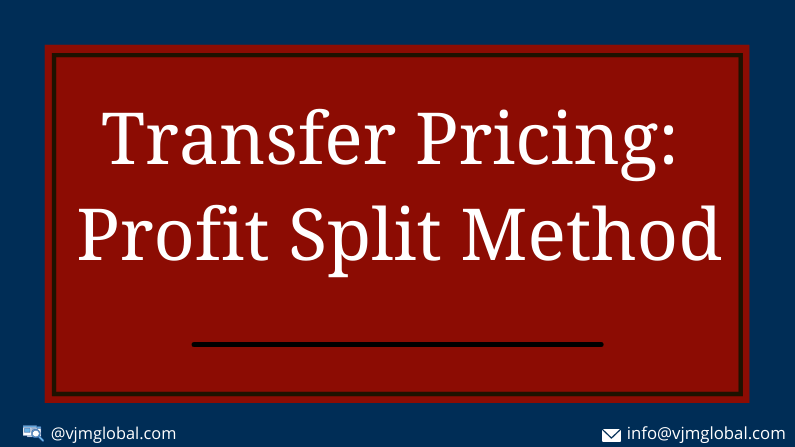For tax purposes, companies are required to record the exchange of goods using the arm’s-length principle. India’s Income-tax Act, 1961 prescribes the various methods to determine the arm’s length price between two affiliated companies. One of these key methods is the Profit Split Method. This article will shed light on how this method works, when to use it, and what are its various advantages and disadvantages.
1. What is the Profit Split Method (PSM) in Transfer Pricing
The Profit Split Method is one of the key methods used in transfer pricing which is typically used when both or all enterprises involved in the transaction have made a significant contribution towards the supply of either goods or provision of services. This method basically eliminates the effect of special conditions as a result of the joint contract in such a manner that each enterprise receives a share of profit that it would have expected to realise otherwise in an independent transaction.
This popular method begins with identifying the profits sharing ratio between the associated enterprises relative to the contribution that each enterprise has made to the transaction. Here, it is important that this profit split must reflect the enterprise’s contribution in terms of functions performed, the risks incurred and the assets owned by the enterprise, used in the process. (This is usually helpful in cases which involve tangible or intangible property or trading activities or financial services.)
The basis on which the profit may be split would vary according to transaction depending on its nature. In cases where the transactions involve heavy investments and form the key factor of the transaction, the profit may be split according to the amount invested. Similarly, profits may be split according to the value of assets used or the direct costs involved.
In certain cases, the associated enterprises perform transactions comparable to those performed by other associated enterprises. In such cases, if the market data about the profit split is available, the same can form a reasonable basis of profit split.
2. How does Profit Split Method Work
In some cases, companies engage in transactions that are too interconnected to be observed on a separate basis.
For example, two related companies might work together on a separate joint venture, such as developing and launching a new brand. As the Profit Split Method looks at the combined profits of two related parties entering into a transaction with one another, it can be used for determining how profits will be divided in a way that is fair to both organizations.
It can be applied in two different ways: the total profit split method and residual profit split method.
Companies select an approach based on how the transaction is structured and the data available.
- To apply the total profit split method, related companies must determine the combined net profit arising from the international transactions [or the specified domestic transaction] in which they are engaged. Such profits represent the profits earned from third parties due to the combined efforts of the related companies.
- The residual profit split method looks at total profits, removes the profits made by the routine functions of both parties, computed using the comparable profits method, and residual profits are split, generally based on each party’s investments and relative spending.
The PSM is most often applied by companies in complex industries with relatively high profits, such as high technology and pharmaceutical organizations. It’s especially useful when dealing with intangible goods, such as intellectual property, as these transactions are often too complex for the other methods to be applied.
3. What are the Indian Transfer Pricing Regulations for the Profit Split Method
Rule 10b(1)(d) of the Income Tax Rules, lays down the Indian Transfer Pricing Regulation for the Profit Split Method as following:
- The combined net profit of the associated enterprises arising from the international transaction in which they are engaged, is determined;
- The relative contribution made by each of the associated enterprises to the earning of such combined net profit, is then evaluated on the basis of the functions performed, assets employed or to be employed and risks assumed by each enterprise and on the basis of reliable external market data which indicates how such contribution would be evaluated by unrelated enterprises performing comparable functions in similar circumstances;
- The combined net profit is then split amongst the enterprises in proportion to their relative contributions, as evaluated under point (2) above;
The profit thus apportioned to the assessee is taken into account to arrive at an arm‟s length price in relation to the international transaction.
4.Computation of Arm’s length price under Profit Split Method
4.1 For the computation of Arm’s Length Price under the Total Profit Split Method the following steps need to be followed:
Step 1– Determine the combined net profit of the Associate Enterprises (AEs) arising from the international transactions [or the specified domestic transaction] in which they are engaged. Such profits represent the profits earned from third parties due to the combined efforts of the AEs. It may be noted that the ‘combined net profit’ referred to in the rule is not the aggregate of entire profits earned by the AEs
Step 2– Evaluate relative contribution made by each entity involved in the transaction on the basis of:
- functions performed;
- assets employed;
- risks assumed;
- the reliable external market data indicating how such contributions would be evaluated by unrelated enterprises performing comparable functions in similar circumstances. It may be noted that reference to ‘external market data’ indicates comparable uncontrolled transactions.
Step 3– Thereafter, split the combined net profit in proportion to the relative contribution determined as above.
Step 4– The profit so apportioned is taken to arrive at the arm’s length price in relation to the international transaction [or the specified domestic transaction].The profits so apportioned to the AE when added to the costs incurred by it in relation to international transaction [or the specified domestic transaction] would result in arm’s length price.
4.2 For the computation of Arm’s Length Price under the Residual Profit Split Method the following steps need to be followed:
Step 1– Determine the combined net profit of the AEs arising from the international transactions [or the specified domestic transaction] in which they are engaged.
Step 2– At the first stage, depending on functions performed, assets employed and risks assumed, determine the basic return appropriate to the respective activities. Allocate the combined net profit on the basis of above. This step results in a partial allocation of the combined net profit to each enterprise. For this purpose, the allocation is undertaken with reference to margins of comparable uncontrolled entities.
Step 3– the balance of the combined net profit is allocated on the basis of the evaluation of the relative contribution.
Step 4– the total net profit from such two-tier allocation is taken to arrive at the arm’s length price. The profits so apportioned to the AE when added to the costs incurred by it in relation to international transaction [or the specified domestic transaction] would result in arm’s length price.
5. When should my company use the Profit Split Method
The Profit Split Method works only under specific circumstances and therefore, to ensure viability of its results, it is highly recommended that one must consider the following points before proceeding with this method:
Complex Integrated Transactions–The Profit Split Method will have to be used when the transactions are highly interconnected and it is practically impossible to evaluate the transactions on their own. Cases, where the entities incur joint costs or earn combined revenues are examples, where only profit split method would result in inappropriate results.
Determination of factors deciding profit split– A reliable understanding of the factors contributing to the profit split decision is prerequisite to using this method. The enterprises must be able to identify the factors which form the basis of distributing the profits. If profits cannot be distributed on any rational basis, this method would not provide reliable results.
Value Additions by all Enterprises– Where each enterprise involved the transaction contributes functionally or by providing significant transfer of unique intangible assets, one-sided approaches adopted in traditional methods provide inconclusive results while the profit split method would be more appropriate.
6. Advantages and Disadvantages of Profit Split Method
Advantages
- The method is suitable when the transactions are highly integrated and the transfer price cannot be decided on the basis of a one-sided approach.
- It ensures that the transfer price does not result in extreme results for either of the entities if the residual profit split variation is followed.
- This method carefully deals with the synergies involved in the transaction owing to the combined use of resources or assets.
Disadvantages
- The profit split is more arbitrary and subjective in this method as compared to other methods and thus, the tax authorities would always prefer to have a closer look into the basis of arriving the same.
- Accounting policies may not be consistent amongst associated enterprises especially when they are located in different geographies resulting in difficulty to arrive at combined costs or revenue.
- External data with regards to profit split isn’t readily available in most cases.













